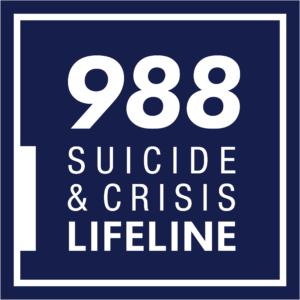Resources to Prevent Suicide Deaths in Construction
 In 2021, construction workers were disproportionately affected by suicide deaths. Almost one-fifth (17.9%) of deaths by suicide where occupational industry was reported were in construction, despite construction workers accounting for only 7.4% of the workforce.1 It has been apparent for a number of years now that the construction industry has one of the highest suicide rates compared to other industries.2
In 2021, construction workers were disproportionately affected by suicide deaths. Almost one-fifth (17.9%) of deaths by suicide where occupational industry was reported were in construction, despite construction workers accounting for only 7.4% of the workforce.1 It has been apparent for a number of years now that the construction industry has one of the highest suicide rates compared to other industries.2
There is not a simple answer to why this increase has occurred – particularly among construction workers. However, just as we develop and identify resources to help workers and employers prevent visible injuries and illnesses, we are also committed to preventing those that may be less visible but equally as important to the safety, health, and well-being of the construction workforce.
There are a growing number of resources available to help organizations and individuals understand the issue, start a conversation, and play a role in supporting friends, co-workers and family members. The list below is intended to help construction employers, unions and workers quickly find information on suicide prevention.
Latest Resources from CPWR
Suicide rates for male construction workers are almost twice as high as for working men overall. Construction workers overall account for about 17% of overdose deaths among the working population, even though they are only about 8% of the U.S. workforce. CPWR partners with North America’s Building Trades Unions (NABTU) and people across the industry to develop and share strategies for improving workers’ mental health, including preventing deaths from suicide and opioids. These efforts include REASON (Resources and Effective programs Addressing Suicide and Opioids Now), a quarterly newsletter that shares solutions, research, and resources, and five research studies funded by CPWR designed to advance knowledge and action.
Click on a topic to see a list of linked resources.
Statistics and Reports
- CPWR: Mental Health, Opioids and Suicide: An Interdisciplinary Annotated Bibliography
- CPWR: Mental Health Trends in the Construction Industry: A Look at Anxiety, Depression, Psychological Distress, Suicides, and Overdoses (CPWR Data Bulletin, September 2024)
- CPWR: Psychological distress and suicidal ideation among male construction workers in the United States
- Bohnert and Ilgen, New England Journal of Medicine (2019): Understanding Links among Opioid Use, Overdose, and Suicide
- CPWR: Workshop on Combating Suicide and Overdose Fatalities Among Construction Workers
- Harris et al, American Journal of Industrial Medicine (2024): Suicides among construction workers in the United States, 2021
- Applebaum et al, American Journal of Industrial Medicine (2019): Suicide and drug‐related mortality following occupational injury
- Choi, International Archives of Occupational and Environmental Health (2018): Job strain, long work hours, and suicidal ideation in US workers: a longitudinal study
- CDC: Preventing Suicide Through a Comprehensive Public Health Approach
- CDC: Stats of the State – Suicide Mortality
Hazard Alert Card, Toolbox Talks, and Infographics
- CPWR Hazard Alert: Preventing Suicide Prevention in Construction (English, Spanish)
- CPWR Toolbox Talk: Suicide Prevention in Construction (English, Spanish)
- CPWR Toolbox Talk: Workplace Stress (English; Spanish)
- CPWR Toolbox Talk: Shift Work, Long Hours, and Fatigue: English; Spanish)
- CPWR Infographic: Start a Conversation (English, Spanish)
- CPWR Infographic: Reach Out (English, Spanish)
- NIOSH Infographic: Suicide Awareness (English, Spanish)
Training Programs
- CPWR: Building Resilience – Training Activities to Promote Construction Worker Well-being
A free discussion-based training with 9 modules that cover topics such as general health, suicide awareness, motivational interviewing, and opioid awareness. Each module can be taught in 30–60-minute sessions — pick and choose those that work for you. Accompanying the training are introductory slides and a participant guide. - CIASP: Suicide Prevention Training
A 60–90-minute training that teaches you to recognize the signs and what to do if you are worried about someone. CIASP offers this LivingWorks training for free for up to 5 people within your organization.
Webinars, Blogs
- CPWR Webinar: Suicide Prevention in the Construction Industry: Know the Signs and Help a Life
September 13, 2023
Play Recording Download Presentation - CPWR Webinar: Preventing Suicide in the Construction Industry
September 9, 2022
Play Recording Download Presentation - CPWR Webinar: Supporting Construction Workers: Suicide Prevention, Mental Health, and Substance Use
April 29, 2021
Play Recording Download Slides - NIOSH: Blogs
Other Resources
- Talking About Suicide in the Construction Industry — This guide is designed to help anyone starting a conversation about mental health — trainers, presenters, peer supporters, media members, etc. — better use existing materials such as presentations, training modules, and research-based approaches, especially to address suicide prevention.
- Construction Industry Alliance for Suicide Prevention (CIASP)
- NIOSH: Suicide and Occupation
- CDC: Mental Health
- Suicide Prevention Resource Center: Online Library
- The Associated General Contractors of Missouri (AGCMO): Suicide Prevention in Construction Industry
- American Foundation for Suicide Prevention
- National Action Alliance for Suicide Prevention
1Harris W, Trueblood AB, Yohannes T, Rodman CP, Rinehart R. Suicides among construction workers in the United States, 2021. Am J Ind Med. 2024; 1-8. doi:10.1002/ajim.23632
2Sussell A, Peterson C, Li J, Miniño A, Scott KA, Stone DM. Suicide Rates by Industry and Occupation — National Vital Statistics System, United States, 2021. MMWR Morb Mortal Wkly Rep 2023;72:1346–1350. DOI: http://dx.doi.org/10.15585/mmwr.mm7250a2.